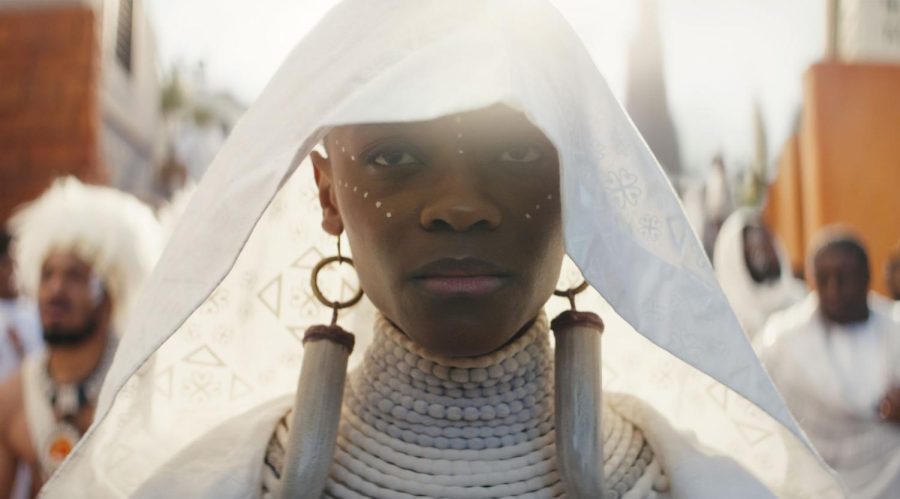Editor’s Note: This review contains spoilers for Black Panther: Wakanda Forever and other phase four films.
Grief has become a major focus for the Marvel Cinematic Universe’s (MCU) phase four. From Peter Parker losing Aunt May in “Spider-Man: No Way Home” to Wanda Maximoff coming to terms with the death of the Vision, Marvel Studios have successfully pulled at the audience’s heartstrings. However, MCU’s new installment, “Black Panther: Wakanda Forever,” is different.
With the heartbreaking death of actor Chadwick Boseman, who portrayed Black Panther, came the uncertainty of the Black Panther sequel. Questions arose within Marvel Studios as well as in the public as to whether the film should be shelved or if the billion-dollar franchise should continue. Ultimately, the film’s release date would be pushed back to November 2022under the direction of Ryan Coogler, the director of the first Black Panther film.
It is safe to say, Coogler did not disappoint with this film. With the dealing of Boseman’s death, the passing of the torch and the strange new threat presented, “Black Panther: Wakanda Forever” gracefully provides an amazing film going experience for MCU fans of any age.
The film opens on a black screen and dialogue from Letitia Wright’s Shuri as she prays to the ancestors of Wakanda. We then find out that Boseman’s T’Challa has fallen ill to an unnamed disease. Shuri struggles to synthesize the heart-shaped herb that was destroyed in the first movie. The herb would presumably cure T’Challa from the illness, but before Shuri can take a gamble on a poorly synthesized herb, Angela Basset’s Queen Mother Ramonda gives Shuri a disgruntled look and the mother and daughter comfort themselves after losing the King.
The opening sets the stage for the emotional journey Shuri goes through in the film. Throughout the movie Shuri struggles with her grief as she buries herself in lab work a year after her brother’s death. Shuri also finds conflict in the mantle of the Black Panther as she sees it as a part of the antiquated past that failed to save her brother.
As Shuri is dealing, or more accurately neglecting, her grief, a new threat emerges from the depths of the ocean when the U.S. begins to look for Vibranium outside of Wakanda. Little does the government know that they are trespassing on the territory of the Talokanil. Rising from the water is Tenoch Huerta’s, Ku’ku’lkán. This iteration of Namor the Sub-Mariner is quite a departure from the source material as the filmmakers decided to base the character’s background on ancient Mayan culture.
Ku’ku’lkán was born a mutant after his mother’s tribe was plagued with smallpox after Spanish conquistadors took hold of the Oaxacan peninsula. In desperation, the tribe’s shaman searches for something that will save his people and comes across an herb not too dissimilar from the heart-shaped herb found in Wakanda. After talking the water plant, the tribe is cured from smallpox but needs to live underwater in order to survive. After his mother’s death, Ku’ku’lkán grants her dying wish of being buried in her native land.
The tribe encounters a Spanish plantation that enslaves indigenous people. This filled the young Ku’ku’lkán with rage as he orders his men to burn the plantation and kill the owners. A dying priest refers to Ku’ku’lkán as “el niño sin amor (the boy without love).” This inspired allowed Ku’ku’lkán’s “villainous” name, to be to as Namor.Namor does not want to be discovered, paralleling the fight to preserve the true nation of Wakanda from to the public in the past film.
The film reached new heights in the MCU in virtually every aspect. The visual effects are stellar, the cast had perfect chemistry and the story was exactly what this film needed it to be. The thing that got my attention the most was the use of the film score, composed by Ludwig Göransson. Whenever T’Challa was mentioned in the film, there would not be any music playing. It would not be until the end of the film, when Shuri finally comes to terms with her brother’s passing, that we hear any music. Another moment being the lack of the iconic “Wakanda” theme. It is not until Shuri makes the moral decision to spare Namor at the end of the film that the theme appears, signaling that Shuri finally earned the mantle of the Black Panther.
The film offers so much more like cameos from Julia Louis-Dreyfus as Contessa Valentina Allegra de Fontaine or the return of Michael B. Jordan as Erik Killmonger and a mid-credit scene that paves a way for so many different Black Panther stories. For those doubting the MCU’s quality as of late, “Black Panther: Wakanda Forever” offers a grounded and genuinely depressing chapter in the ever-growing cinematic universe.
Lastly, as a Chicanx student, it is life changing to see a character who looks like me enter the mainstream media. Tenoch Huerta is not afraid to showcase his culture and for millions of children across Latin America and in the U.S., this pride of Latinx culture sets a wonderful example. It seems that once again, the Black Panther franchise lends a spotlight to multiple beautiful cultures.
Emmanuel Rivas Valenzuela is the sports editor and may be reached at [email protected]: @rivasemmanuel2 on Instagram












